The Li-ion exchange process is illustrated in Fig. 1(a). The Na
2W
4O
13 nanosheets (Fig. S1) were synthesized using the molten salt method, as described in a previous study [
14]. Li-ion exchange could occur with the addition of Na
2W
4O
13 nanosheets into the Li
2SO
4 solution, which was under stirring for several days. The Li-ion-exchanged sample was collected by vacuum filtration after being extensively soaked and washed using DI water, which was followed by drying at 70°C. The dispersity of the Na
2W
4O
13 nanosheets in DI water significantly improved after the Li-ion exchange process. Figure 1(b) shows the optical image of the ink of pristine Na
2W
4O
13 and Li
xNa
2−xW
4O
13 having the same concentration of 1 mg/mL. The dispersion of Li
xNa
2−xW
4O
13 is more transparent with a strong Tyndall effect owing to the nanosize of the material, which suggests better dispersibility than the pristine Na
2W
4O
13. Furthermore, the sedimentation curves of suspension when the same initial concentration of 2 mg/mL is considered are shown in Fig. 1(c). Figure 1(c) shows that the concentration of the pristine Na
2W
4O
13 nanosheets decreased to become less than 0.8 mg/mL after three days, whereas the concentration of the Li
xNa
2−xW
4O
13 nanosheets became greater than 1.2 mg/mL after only two weeks. This improved dispersity of the Li
xNa
2−xW
4O
13 nanosheets in DI water was further confirmed based on the enhanced zeta potential (Fig. 1(d)). According to the Derjaguin-Landau-Verwey-Overbeek (DLVO) theory on colloid stability, the dispersed nanosheets, which can be considered to be nanoparticles, do not undergo aggregation because of the sufficient electrostatic repulsive force caused by the electric double layer around the nanosheets [
39,
40]. The resultant repulsion is generally characterized by the zeta potential. As shown in Fig. 1(d), with an increase in the Li-ion exchange time, the zeta potential of the modified nanosheets decreased from −40 to −55 mV, indicating the improved dispersity in water. The atomic ratio of sodium and tungsten in these samples gradually decreased from 0.46 to 0.19, which was determined by following the Li-ion exchange process based on the inductively coupled plasma optical emission spectroscopy (ICP–OES) analysis. Moreover, the total content of alkali metal ions (Li and Na) in these samples remained the same as that of the initial Na
2W
4O
13 (Fig. S2), which indicated that the exchanged Li ions in the sample improve the dispersity.








